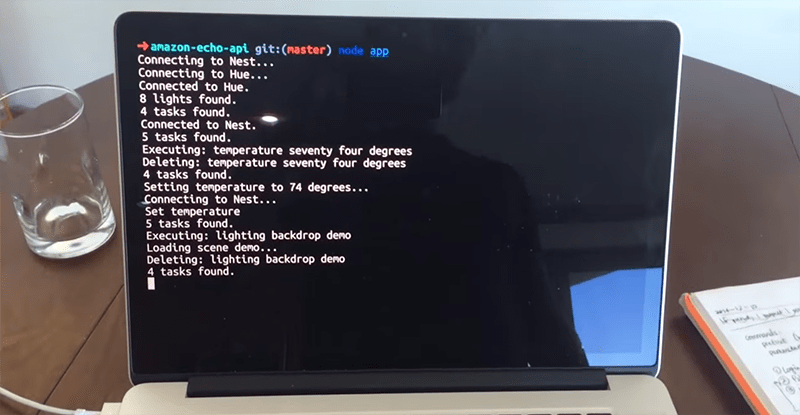There’s a bright future ahead of us, filled with intelligent computerized assistants that will listen to everything we say and do our bidding. It’ll be like HAL from 2001: A Space Odyssey, but without unverified mission-critical software and a bunch of killing. Until then, we have a few Amazon Echo hacks that tease out a reasonably capable home automation system without a proper API.
This build was inspired by an earlier project that polled the to do list looking for key phrases. Saying, “Alexa, to do, lights on” would turn on an Internet-connected light bulb. Saying, “Alexa, to do, call home” would call a phone number set up with the ‘home’ keyword.
[Glen] has improved that earlier setup somewhat, mostly by getting rid of the requirement to say, ‘to do.’ The Git for the project still shows it’s exploiting the Amazon to do list, but this is a much cleaner build that should end up having a lot more possibilities.
So far, [Glen], or rather, Alexa, can control the temperature of the house through a Nest thermostat, the lighting of a room with a Phillips Hue light bulb, and other random tasks like playing an audio file through the speakers. Not bad, and something that really demonstrates the potential of a smart, connected home.















Please make it clearer which is the main link for each post. Put a copy if the link at the end or bold it or icon it or whatever. Just make it consistent.
Agreed, Or just a link at the bottom of the article somewhere?
They edited my comment. “or [ source ] link at the bottom”
> Just make it consistent.
It is. It is almost always, with very few and very obvious exceptions, the first link.
Doing a source thing at the bottom would be easy, though. Consider that under consideration.
> [Glen] has improved that earlier setup somewhat, mostly by getting rid of the requirement to say, ‘to do.’
Yet, in the video, there clearly is that awkward “Alexa, to-do” [wait several seconds] »What’s the to-do?« before each real command.
I’m not really sure what benefit echo has over a small arm board in an enclosure hooked up to a parabolic microphone? I think people become transfixed by consumer level technology.
From the audience here I would have expected the mass denigration of Echo and suggestions and subsequent projects implementing cutting edge but extremely unstable (the best kind) of software to perform the task many times better (disregarding the occasional crash or cranky AI house-fire).
Because a parabolic microphone would not be all that useful for a home automation system. It is very directional which is not good for this application.
Ideally you would want a phased array fo microphones that scanned the area for people speaking and then became directional to the speaker.
The Echo is interesting because it already does a lot of the heavy math for you as far as DSP and and the heavy lifting as far as voice recognition.
I’m going to say the engineering hours spent developing some accurate speech recognition and mass production
So.. is internet connection required?
Doubtful, as long as all of the components are connected to the same network. One could use a secondary network hooked up in the home for this which was isolated from an internet facing network.
Yes, the echo will not function without the internet.
Nothing at all alarming there…
Every once in a while, tell your listening computers to order coffee for the federal agents listening in. If nobody is listening it costs you nothing, and if they are then they have to turn down the coffee (since you’d see the charge on your card). It’s like the surveillance version of Pascal’s Wager.
This would be much more fun to read if the headlines wouldn’t eat up 3/4 of my screen.
Or just run all open-source:
http://stevenhickson.blogspot.in/2013/06/installing-and-updating-piauisuite-and.html
Geez, nest AND amazon. Why not just lay out a guestroom for a NSA guy.
I do enjoy the idea of Echo being used for Home Control and general assistance. I like the efforts shown here and any HA post on HaD really. It would be nice to see people using HA devices other than those sold at the Apple store (hue/nest). There is a whole world of devices and control options.
I agree Tim. Conceptually this should work with Insteon as well, right?
This is awesome! I would totally as well love to see this work with my Insteon setup, however my skills around this conversion are extremely lacking…
I responded to Amazon’s offer on November 6. Received email from Amazon on January 6 that I could place my order ($99). Received email shortly after that I would receive echo on February 18. Received email from Amazon late February 7 that I would receive echo on February 11.
This is so cool! I’ve heard a lot about Amazon Echo recently. I find the concept of home automation so fascinating. I remember watching movies with similar ideas when I was younger, and I just thought it was the coolest thing. It’s crazy to see how far technology has come in the past few years.
Brook | http://www.kazelectronics.com.au/services/electrical
My husband is in wheelchair and the ramp he uses is in our garage to go outside. I bought him an echo for father’s day and am trying to determine if there is a less expensive way for him to open garage door with echo. Any ideas?